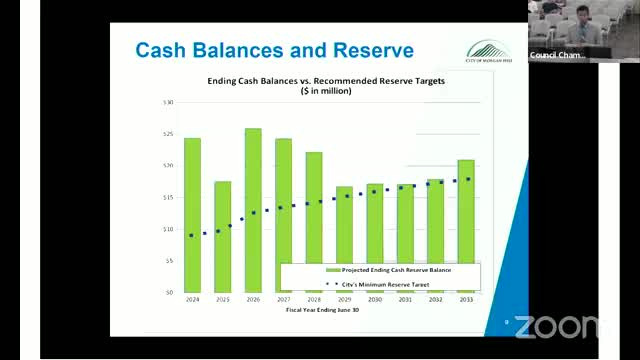Council debates controversial sewer rate hike proposal
June 26, 2024 | Morgan Hill, Santa Clara County, California

This article was created by AI summarizing key points discussed. AI makes mistakes, so for full details and context, please refer to the video of the full meeting. Please report any errors so we can fix them. Report an error »

During a recent city council meeting, officials discussed proposed adjustments to the sewer rate structure, which could significantly impact residents' utility bills. The proposed changes include a shift towards a fixed-rate model, which has raised concerns among council members and residents regarding fairness and affordability.
Currently, residents pay an average of $50 per month for sewer services, but under the new proposal, some could see increases of up to 40% or more, particularly those who consume less water. Council member Spring expressed strong opposition to the proposed fixed-rate structure, arguing that it would disproportionately penalize low-water users, such as single-person households, while benefiting larger households that consume more. This sentiment was echoed by other council members, who highlighted the potential financial strain on low-income residents already facing rising costs in other areas, such as food and energy.
The city staff defended the proposed changes, stating that the fixed-rate model is designed to cover the fixed costs of maintaining the sewer system, which do not fluctuate based on individual water usage. They emphasized that the current structure, which combines fixed and volumetric rates, may not generate sufficient revenue to support necessary infrastructure improvements.
In addition to the rate adjustments, the council discussed the introduction of a low-income subsidy program, which aims to assist residents who may struggle with the increased costs. Currently, the subsidy provides $7.13 per account, but staff recommended increasing this amount in line with the proposed rate adjustments.
The council also considered the impact of new developments, particularly accessory dwelling units (ADUs), which could generate additional revenue for the sewer system. Staff projected that charging new ADUs could bring in approximately $23,000 annually, helping to offset some of the costs associated with the proposed rate increases.
As the council prepares to finalize the rate structure, residents and officials alike are grappling with the implications of these changes. The council plans to revisit the discussion after the summer recess, with a focus on balancing the need for infrastructure funding against the financial realities faced by residents.
Currently, residents pay an average of $50 per month for sewer services, but under the new proposal, some could see increases of up to 40% or more, particularly those who consume less water. Council member Spring expressed strong opposition to the proposed fixed-rate structure, arguing that it would disproportionately penalize low-water users, such as single-person households, while benefiting larger households that consume more. This sentiment was echoed by other council members, who highlighted the potential financial strain on low-income residents already facing rising costs in other areas, such as food and energy.
The city staff defended the proposed changes, stating that the fixed-rate model is designed to cover the fixed costs of maintaining the sewer system, which do not fluctuate based on individual water usage. They emphasized that the current structure, which combines fixed and volumetric rates, may not generate sufficient revenue to support necessary infrastructure improvements.
In addition to the rate adjustments, the council discussed the introduction of a low-income subsidy program, which aims to assist residents who may struggle with the increased costs. Currently, the subsidy provides $7.13 per account, but staff recommended increasing this amount in line with the proposed rate adjustments.
The council also considered the impact of new developments, particularly accessory dwelling units (ADUs), which could generate additional revenue for the sewer system. Staff projected that charging new ADUs could bring in approximately $23,000 annually, helping to offset some of the costs associated with the proposed rate increases.
As the council prepares to finalize the rate structure, residents and officials alike are grappling with the implications of these changes. The council plans to revisit the discussion after the summer recess, with a focus on balancing the need for infrastructure funding against the financial realities faced by residents.
View full meeting
This article is based on a recent meeting—watch the full video and explore the complete transcript for deeper insights into the discussion.
View full meeting
